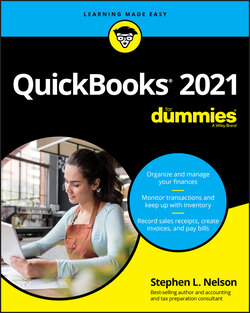Читать книгу QuickBooks 2021 For Dummies - Nelson Stephen L., Stephen L. Nelson - Страница 28
The trial balance of the century
ОглавлениеAfter you decide when you want to convert, you need a trial balance.
“Yikes!” you say. “What’s a trial balance?” A trial balance simply lists all your assets, liabilities, and owner’s equity account balances, as well as the year-to-date income and expense numbers on a specified date (which, not coincidentally, happens to be the conversion date). You need this data for the QuickBooks Setup process and for some fiddling around that you need to do after you complete the process.
Creating a trial balance doesn’t have to be as hard as it sounds. If you’ve been using another small-business accounting system, such as the simpler Quicken product from Intuit or the Simply Accounting program from Computer Associates, you may be able to have your old system produce a trial balance on the conversion date. In that case, you can get the balances from your old system. (Consider yourself lucky if this is the case.)
Just to split hairs, the trial balance should show account balances at the start of the first day you use QuickBooks for accounting. If the conversion date is 1/1/2021, for example, the trial balance needs to show the account balances at one minute past midnight on 1/1/2021. This is the same thing as showing the account balances at the end of the last day that you’ll be using the old accounting system — in other words, at midnight on 12/31/2020 if you’re converting to QuickBooks on 1/1/2021.
If your old system is rather informal (perhaps it’s a shoebox full of receipts), or if it tracks only cash (perhaps you’ve been using Quicken), you need to do a bit more work:
To get your cash balance: Reconcile your bank account or bank accounts (if you have more than one bank account) as of the conversion date.
To get your accounts receivable balance: Tally all your unpaid customer invoices.
To get your other asset account balances: Know what each asset originally costs. For depreciable fixed assets, you also need to provide any accumulated depreciation that has been claimed for that asset. (Accumulated depreciation is the total depreciation that you’ve already expensed for each asset.) By the way, check out Appendix B if you have questions about accounting or accounting terminology, such as depreciation.
To get your liability account balances: Know how much you owe on each liability. If you trust your creditors — the people to whom you owe the money — you may also be able to get this information from their statements.
You don’t need to worry about the owner’s equity accounts. QuickBooks can calculate your owner’ equity account balances for you, based on the difference between your total assets and your total liabilities. This method is a bit sloppy, and accountants may not like it, but it’s a pretty good compromise. (If you do have detailed account balances for your owner’s equity accounts, use these figures — and know that you’re one in a million.)
If you’re using the slightly awkward way to convert to QuickBooks — in other words, if your conversion date is some date other than the beginning of the accounting year — you also need to provide year-to-date income and expense balances. To get your income, cost of goods sold, expenses, other income, and other expense account balances, you need to calculate the year-to-date amount of each account. If you can get this information from your old system, that’s super. If not, you need to get it manually. (If you suddenly have images of yourself sitting at your desk late at night, tapping away on a ten-key, you’re probably right. What’s more, you probably also need to allocate half of another Saturday to getting QuickBooks up and running.)
Just for fun, I created the sample trial balance shown in Table 2-1. This table shows you what a trial balance looks like if you convert at some time other than at the beginning of the accounting year.
TABLE 2-1 A “Slightly Awkward Way” Sample Trial Balance
| Trial Balance Information | Debit | Credit |
|---|---|---|
| Assets | ||
| Checking | $5,000 | |
| Fixed assets | $60,000 | |
| Accumulated depreciation (fixed assets) | $2,000 | |
| Liabilities information | ||
| Loan payable | $10,000 | |
| Owner’s equity and income statement information | ||
| Opening balance equity | $20,000 | |
| Sales | $60,000 | |
| Cost of goods sold | $20,000 | |
| Supplies expense | $2,100 | |
| Rent expense | $4,900 | |
| Totals | $92,000 | $92,000 |
If you’re converting at the beginning of the accounting year, your trial balance instead looks like the one shown in Table 2-2. Notice that this trial balance doesn’t have any year-to-date income or expense balances.
TABLE 2-2 A “Right Way” Sample Trial Balance
| Trial Balance Information | Debit | Credit |
|---|---|---|
| Assets | ||
| Checking | $5,000 | |
| Fixed assets | $60,000 | |
| Accumulated depreciation (fixed assets) | $2,000 | |
| Liabilities information | ||
| Loan payable | $10,000 | |
| Owner’s equity and income statement information | ||
| Opening balance equity | $53,000 | |
| Totals | $65,000 | $65,000 |
